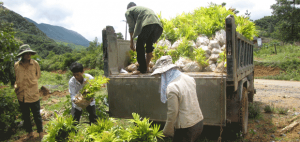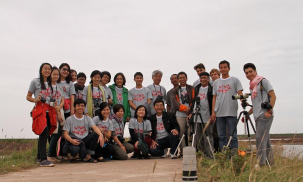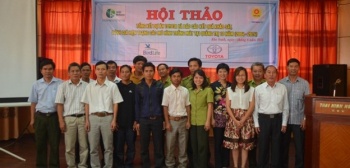Rattan planting for livelihoods and conservation in central Vietnam
By Martin Fowlie (BirdLife International)
Over the last two years, under a BirdLife International Local Empowerment Programme project funded by Toyota Motor Corporation and Nando Peretti Foundation, communities in the buffer zones around forest reserves in Vietnam have been planting valuable native rattan. This will provide a resource for sustainable livelihoods, while helping conserve forest biodiversity.
Lowland forest in central Vietnam was devastated by years of war, and then over-exploited to support a growing population and accelerating economic development. Much of what remains is fragmented and degraded. Wild resources are being rapidly depleted by development, conversion to agriculture and plantations, illegal logging and hunting.
Yet central Vietnam remains one of the poorest regions of the country. Communities (especially indigenous ones) often lack arable land and are dependent on natural resources from the forests.
The Annamese Lowlands Endemic Bird Area in central Vietnam is a focus for BirdLife International’s Vietnam Programme. All the restricted-range species are found in lowland forest.
Since January 2012, BirdLife’s Vietnam Programme, Viet Nature Conservation Centre (Viet Nature) and Quang Tri Forest Protection Department have jointly introduced a model of forest protection, sustainable natural resource management and benefit sharing never seen before in Vietnam. As part of a new model for forest conservation in Vietnam, this may offer the best chance of survival for the Critically Endangered Edwards’s Pheasant Lophura edwardsi which is restricted to this part of the Annamese Lowlands EBA.
Under Forest Protection Contracts, communities, community organisations and households are contracted and paid to protect and manage a defined forest area for ten years, with the possibility of extension. They can use the forest’s resources as agreed with the Forest Protection Department.
The scheme offers participants 10-year stewardship of “their” piece of forest, giving them the confidence to plan for the medium term, and reducing transaction costs. The fee is paid in a lump sum upfront to enable participating households to invest in rattan planting. Contract monitoring is carried out by the relevant District Forest Protection Department.
Rattan can be harvested after four to five years, and then for many years into the future, giving households a long-term, stable income. Demand for rattan materials for furniture making and handicrafts is huge. Unlike other seasonal products, it can be harvested when needed, functioning like a “savings bank”.
Currently, there are around 200,000 ha of forest in Quang Tri province, of which 30% is within protected areas. The rest provide huge potential for rattan-based job and income generation and forest stewardship enhancement.
The project has been enthusiastically supported by both communities and local authorities. BirdLife and Viet Nature are seeking funding to replicate the scheme elsewhere in Quang Tri province, and then expand it to neighbouring provinces.
https://www.youtube.com/watch?feature=player_embedded&v=cW76rdFPa6Y

Chia sẻ:










